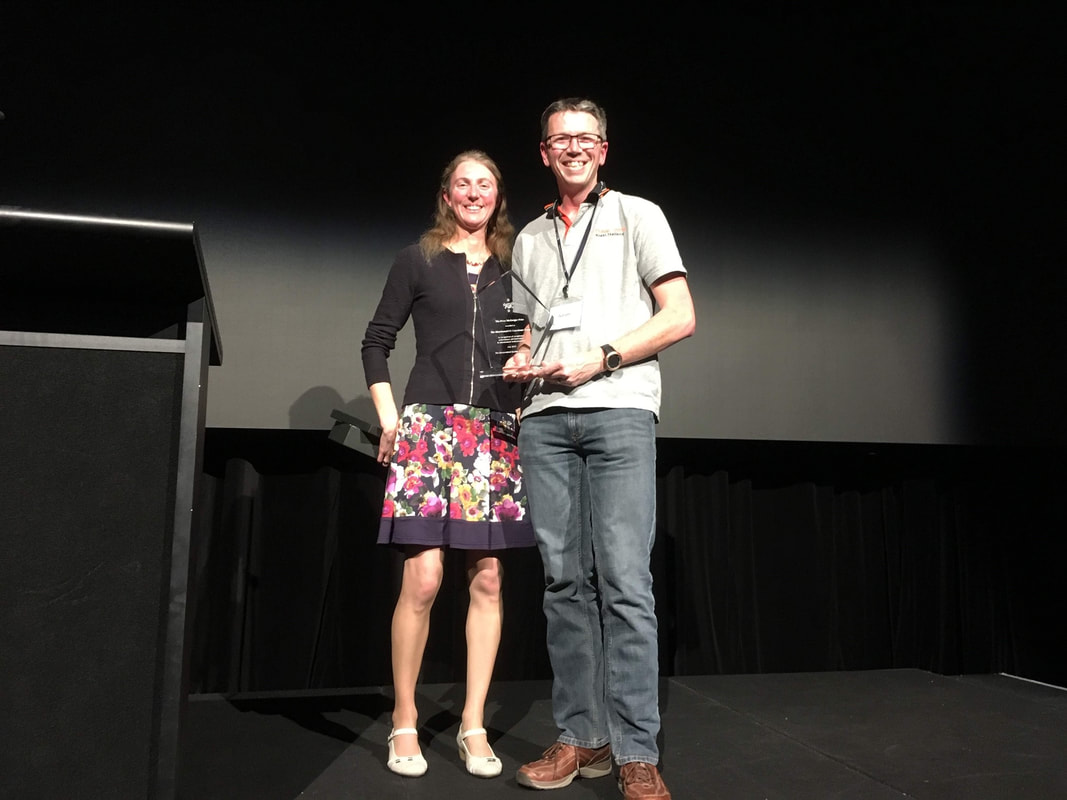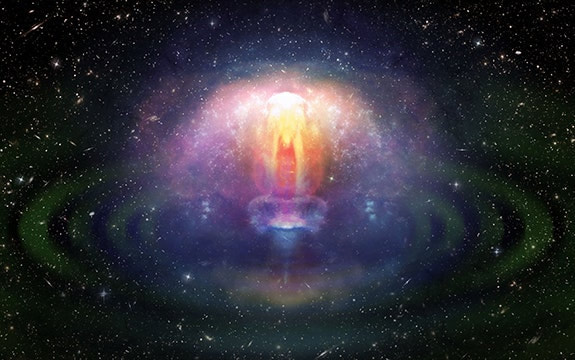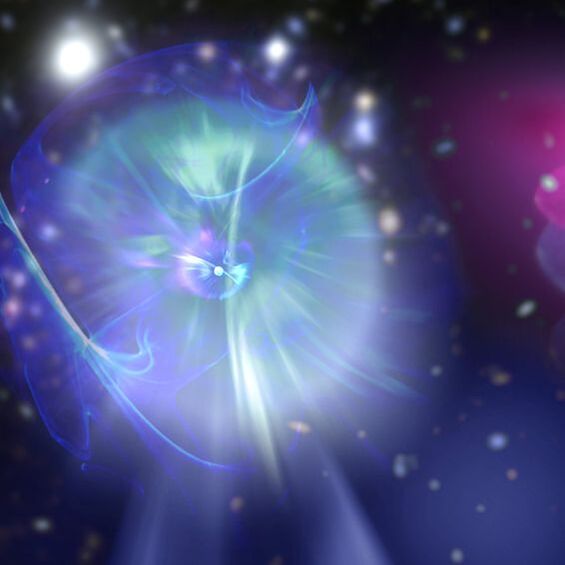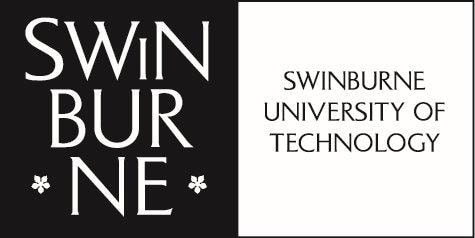|
OzGrav Associate Investigator Adam Deller and the Distributed FX Correlator (DiFX) team was recently awarded the Peter McGregor Prize by the Astronomical Society of Australia (ASA). This is a newly created and prestigious award to celebrate major achievements in the development of astronomical instrumentation and technology, both hardware and software.
The Distributed FX Correlator (DiFX) is a software package that contains tools necessary to turn an array of radio telescope signals into a functioning radio interferometer. The nominations and letters of support made a very strong case arguing the innovative nature of the DiFX and its impact. The DiFX transformed long-baseline interferometry. It has contributed significantly to reducing the barrier to entry and play a major role in radio astronomy research internationally. The system has enabled a wide range of science, as testified by the very high number of references to the key technical papers. The open-access nature of the software has put a new tool in the hands of astronomers, with demonstrated positive results. Its scalability and adaptability continues to enable researchers to tailor its behaviour and pursue what would otherwise be difficult science goals. DiFX was also used to image the black hole event horizon in 2018, so it’s evidently powerful. The DiFX collaboration includes the following contributors: Adam Deller (leader), Walter Alef, James Anderson, Matthias Bark, Matthew Bailes, Walter Brisken, Roger Cappallo, Geoff Crew, Richard Dodson, Dave Gordon, Zheng Meyer-Zhao, John Morgan, Chris Phillips, Cormac Reynolds, Jon Romney, Helge Rottman, John Spitzak, Matteo Stagni, Steven Tingay, Jan Wagner, Mark Wainright, Randall Wayth." Congratulations to everyone involved!
4 Comments
A glimpse into the past, present and future: Hubble constant measured by neutron star fireball9/7/2019 Image by James Josephides. The Hubble constant is one of the most fundamental pieces of information that describes the state of the Universe in the past, present, and future. It tells us how fast the Universe is expanding – a valuable piece of information in science’s search for answers.
The two best ways of estimating the Hubble constant are based on: the background hiss of the Universe left over from the big bang (the ‘Planck’ observations of the cosmic microwave background radiation), and on massive stars blowing themselves to pieces in the distant Universe (‘type 1a supernovae’ observations). According to the measurements of the exploding stars, the Universe is expanding a bit faster than the measurements of the background hiss would indicate, and the difference is now very significant. So, either one of them is incorrect or something is missing in our understanding of physics and cosmology. We’d like to know what is really happening in the Universe, so we need a third, independent check. This is where the merger of two neutron stars can shed some light. Neutron star mergers are phenomenally energetic events – two stars, each more massive than the Earth’s Sun, whip around each other hundreds of times per second before colliding and producing an enormous blast of material, light and gravitational waves. In 2017, gravitational waves and light were first detected from a neutron star merger that had occurred 130 million years ago, in an event scientists refer to as GW170817. Scientists realised that a burst of gravitational waves can be used as a ‘standard siren’: based on the shape of the gravitational wave signal, we can tell how ‘bright’ the event should have been in gravitational waves. We can then measure the actual brightness of the event and work out what the distance must have been. However, this only works well if we know how the merging stars were oriented on the sky (edge on, face on, or somewhere in between). The gravitational wave data itself can’t accurately tell whether a merger was nearby and edge on, or distant and face on. To answer that question, a team including OzGrav Associate Investigator Adam Deller used radio telescopes to take a super-high-resolution movie of a narrow but powerful jet of material left behind after two neutron stars merged in the GW170817 event. The resolution of the radio images was so high, if it was an optical camera, it would see individual hairs on someone’s head 10 km away. By examining the miniscule changes in this radio-emitting bullet of gas (compared against models developed by supercomputers), the angle of the jet and the orientation of the merging neutron stars was found. Using this information, Adam and the team could tell how far away the merging neutron stars were and, by comparing this with how fast their host galaxy is rushing away from the Earth, they could finally work out the prized Hubble constant. Despite this incredible result, which is published in Nature Astronomy today, the current measurement is still not good enough to distinguish between ‘Planck’ vs ‘Type 1a supernovae’. Further observations of merging neutron stars will soon lead to a more accurate Hubble constant. Image by Carl Knox. Inside a small room in the Melbourne suburb of Hawthorn a team of astrophysicists, with a little help from work experience students and a 12-year-old boy, are leading a global hunt for one of the universe’s most mysterious and powerful phenomena. For one week this is the control centre for about 64 telescopes dotted around – and above – the Earth. The team is on the world’s biggest chase for fast radio bursts, mysterious and super-powerful blasts of radio-wave energy visible clear across the universe. But the Deeper Wider Faster team, as it is known, has even bigger ambitions. Over the past few years, astronomers have spotted a number of these bursts. The CSIRO announced on Friday that it had spotted one and traced its location to a galaxy 3.6 billion light years away. But the scientists in the Hawthorn room not only want to spot one; they hope to find out what causes the bursts. Fast radio bursts – astronomers refer to them as FRBs – are extremely short and powerful bursts of radio waves originating from somewhere outside the Milky Way. Some contain more energy within a moment than our sun produces in decades. “It’s a millisecond burst that goes off once, unpredictably. And you have no idea when. Trying to catch that, it’s hard,” says Jeff Cooke, chief investigator at the ARC Centre for Excellence in Gravitational Wave Discovery. He has spent the past half-decade pulling all this together. Last week's telescope global hook-up finished on Saturday. The team hasn't spotted anything thus far, but there were problems with one of the radio telescopes and data analysis will continue to see if anything was missed. No one knows what the bursts are. Most scientists agree they are not linked to aliens. Each astrophysicist in the control room last week at Swinburne University’s Hawthorn campus has their own favourite theory. Professor Cooke hopes they come from magnetars, a kind of neutron star with a super-powerful magnetic field. An incredibly intense "star-quake" on its surface might produce an FRB. Sara Webb hopes the answer is a blitzar, a pulsar that explodes then collapses into a black hole. And Igor Andreoni hopes FRBs come from colliding neutron stars, which generate explosions so powerful they warp the space-time fabric. To find out, the three have spent five years wrangling telescopes around the world to work together. The global coalition ranged from the high-tech – like IceCube, a sensor embedded deep under the Antarctic ice, and the Hard X-ray Modulation Telescope, flying in a low orbit of Earth – to decidedly low-tech: a telescope set up in a Pakenham backyard by an amateur astronomer. The telescopes have been looking at the same patch of sky. But – and here’s the trick – they all look with different eyes. The X-ray Modulation Telescope, for example, sees in X-rays, while IceCube’s one-kilometre-wide sensor is designed to pick up neutrino signatures. Different signals can travel through space at different speeds. Radio waves typically are the slowest. This means by the time a radio telescope detects a fast radio burst, all the other signals – things that could tell us what the FRB actually is – may have already gone racing past the Earth. The hope for last week's hook-up was that by looking with about 64 sets of different eyes, when an FRB fired off the other telescopes would spot something – a burst of light, or X-rays, or anything at all– that gave a clue as to what the FRB really is. The researchers have done six runs at this in the past four years, each time harnessing more and more telescopes. So far, nothing. Data flowed last week from the telescopes around the world to a supercomputer able to pick out anything that could possibly be a signal – like a space explosion – that could generate an FRB. The probabilities told the scientists their radio telescopes would spot one or two FRBs last week. The supercomputer, however, could identify tens of thousands of possible signals every day. The aim was for humans to check any signals within minutes of their happening in order to send a quick command to giant telescopes in Chile and South Africa that stood ready to try to get a good image of the FRB. However, the team will now need to go back over some of the results due to problems with a telescope not providing needed data. Many scientists don’t even believe an FRB will come with another signal. “So that makes it even harder,” Dr Andreoni says. In the control room one day early last week, in charge of assessing the thousands of possible FRBs is that crack team of astrophysicists – and a few work experience students. There are six of the latter, all here for the day from school. They are joined by Blake Iscaro, a 12-year-old with a deep interest in space who matter-of-factly says he is using scavenged parts to build a radio-telescope in his backyard. The supercomputer sprays the data up on the wall. Then it's up to the team to spot something. Fast. “Computers find things you know pretty well. They don’t find things you have not ever seen before,” Professor Cooke says. “If you’re going to trigger these gigantic telescopes, which cost a ridiculous amount of money, you don’t want them to point at something that wasn’t real.” Two stations down from Professor Cooke, year 10 student Max Petschack leans closer to his screen, face screwed up in concentration, staring at what looks like a yellow blob. The light curve shows the blob became dramatically brighter between measurements. “This one’s interesting,” he says. Michelle Ko leans over to look. “Wow,” she says. Max points at the light curve. “That’s a, what, point four difference?” “Yeah, that’s a huge difference,” says Michelle, before calling Dr Andreoni over. He leans over the children’s shoulders, checking their work. Is this the moment? Sadly, he does not think so. There is a lot of turbulence in the atmosphere messing with their brightness measurements. And the dot Max found is too round. “That means it’s probably a star,” Dr Andreoni says. By Liam Mannix - As featured in The Age.
|
|
- Home
- About
-
Our People
- Chief Investigators
- Partner Investigators
- Associate Investigators
- Postdocs and Students >
- Professional & Outreach staff
- Governance Advisory Committee
- Scientific Advisory Committee
- Executive Committee
- Equity & Diversity Committee
- Early Career Researcher Committee
- Professional Development Committee
- Research Translation Committee
- OzGrav Alumni
- Research Themes
- Education and Outreach
- Events
- News/Media
- Contact Us
- Home
- About
-
Our People
- Chief Investigators
- Partner Investigators
- Associate Investigators
- Postdocs and Students >
- Professional & Outreach staff
- Governance Advisory Committee
- Scientific Advisory Committee
- Executive Committee
- Equity & Diversity Committee
- Early Career Researcher Committee
- Professional Development Committee
- Research Translation Committee
- OzGrav Alumni
- Research Themes
- Education and Outreach
- Events
- News/Media
- Contact Us




 RSS Feed
RSS Feed








